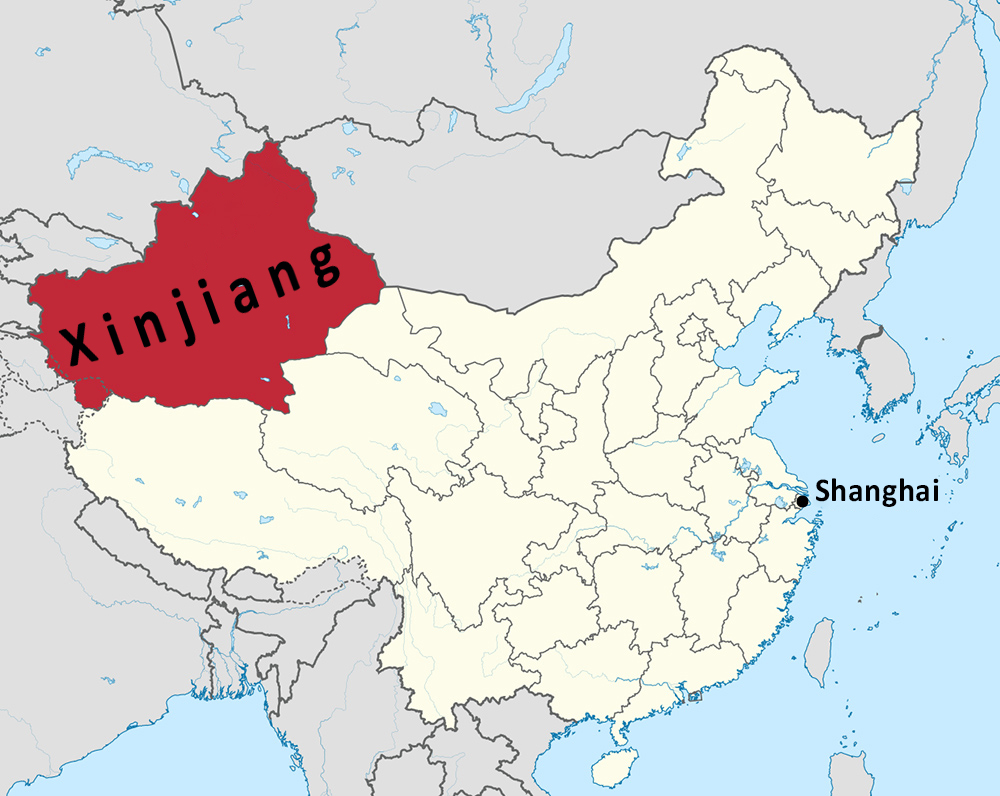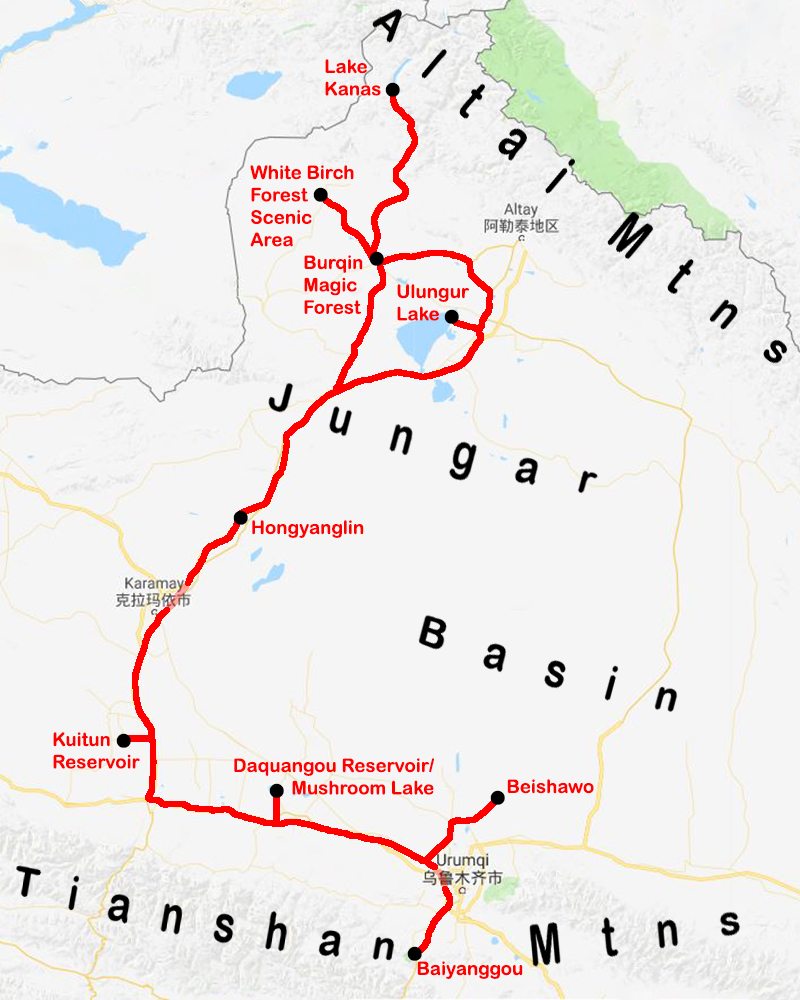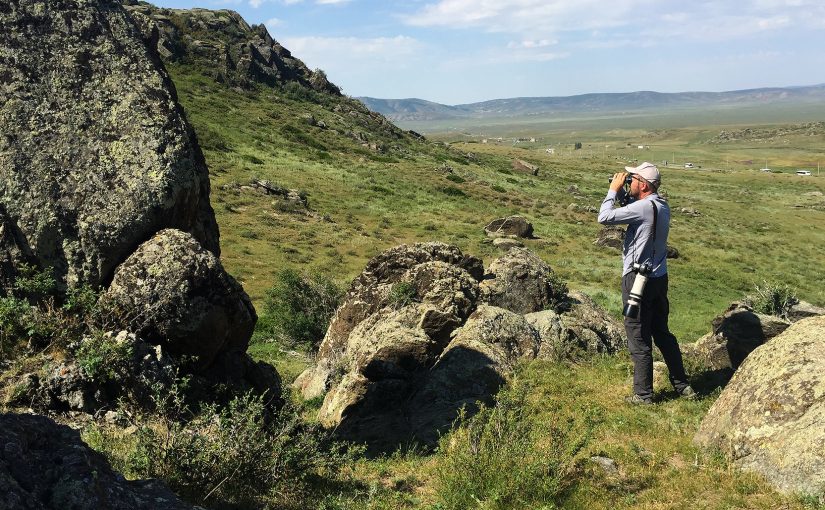by Craig Brelsford
Founder, shanghaibirding.com
In the image above, Beijing-based Swedish birder Jan-Erik Nilsén scans the rocks for Northern Wheatear near Kanasi Airport, 28 July. The point where Jan-Erik is standing is in the Altai Mountains, at the extreme northern tip of Xinjiang, an area closer to Moscow than to Shanghai. In this post, the second in my five-part series on Northern Xinjiang, you will read my notes on the “European” birds of Xinjiang as well as other observations recorded during my expedition of July 2017. — Craig Brelsford
WED 19 JULY
THU 20 JULY
FRI 21 JULY
Urumqi
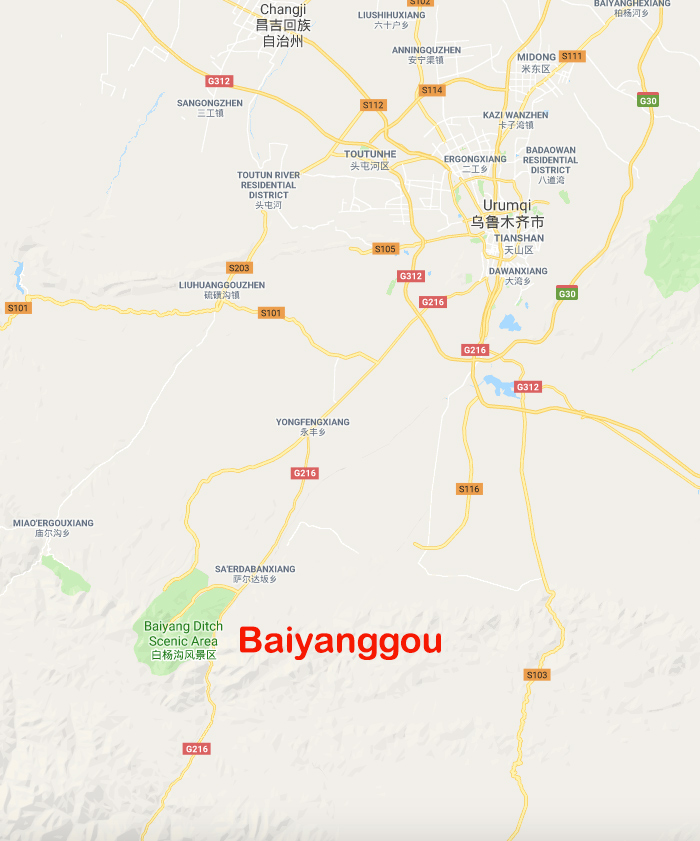
On Fri. 21 July, my Beijing-based Swedish partner Jan-Erik Nilsén and I were at Baiyanggou (43.424675, 87.163545), 65 km (40 mi.) southwest of Urumqi in the Tianshan Mountains.
Among our highlights were spotting-scope views of Himalayan Snowcock Tetraogallus himalayensis, central Palearctic specialties Eversmann’s Redstart Phoenicurus erythronotus, Red-fronted Serin Serinus pusillus, and Azure Tit Cyanistes cyanus, and species familiar to Western Europeans such as Common Quail Coturnix coturnix, singing Common Whitethroat Curruca communis, Tree Pipit Anthus trivialis, Common Linnet Linaria cannabina, and European Goldfinch Carduelis carduelis. I missed Blue-capped Redstart Phoenicurus coeruleocephala, and Red-headed Bunting Emberiza bruniceps and Grey-necked Bunting E. buchanani have been recorded at Baiyanggou.
Not all our activity has been in the Tianshan. A quick trip to Baihu (43.816992, 87.435352), a reservoir in the western suburbs of Urumqi, got us views of White-headed Duck Oxyura leucocephala, an encounter with a family of Chukar Partridge Alectoris chukar, and a heard-only tick of Pallas’s Sandgrouse Syrrhaptes paradoxus.
In Xinjiang, Jan-Erik and I are (and the Han settlers here like to say we are) saiwai (塞外), “beyond the (Great) Wall,” in China, but not in East Asia. We are in Central Asia, thousands of kilometers from the sea, near the center of Eurasia, as the birds we have noted show. Today, with the Tianshan as our backdrop, Jan-Erik and I stood on wavy loess hills made from the buildup over eons of dust borne by wind from distant places on the supercontinent.
The people we have met so far are mostly Han, settlers or descendants of settlers from the east, mainly the northern provinces. As I have noted in other areas of China where Han settlement is recent, everyone here speaks standard Mandarin. There is no local Chinese dialect. As I have been trained in standard Mandarin, my ability to communicate with the locals is greater here than in other areas of China where the vernacular is a non-standard form of Chinese.
I arrived from Shanghai late on Wed. 19 July and spent Thurs. 20 July alone at Baiyanggou. Jan-Erik arrived late on Thurs. 20 July from Beijing.
Our driver today and throughout the trip was Sūn Yǒng Dōng (孙永东), +86 180-9964-0966. Yong Dong is a Han who was born in Urumqi, knows Xinjiang, dabbles in photography, and drives well. We recommend him.
Photo
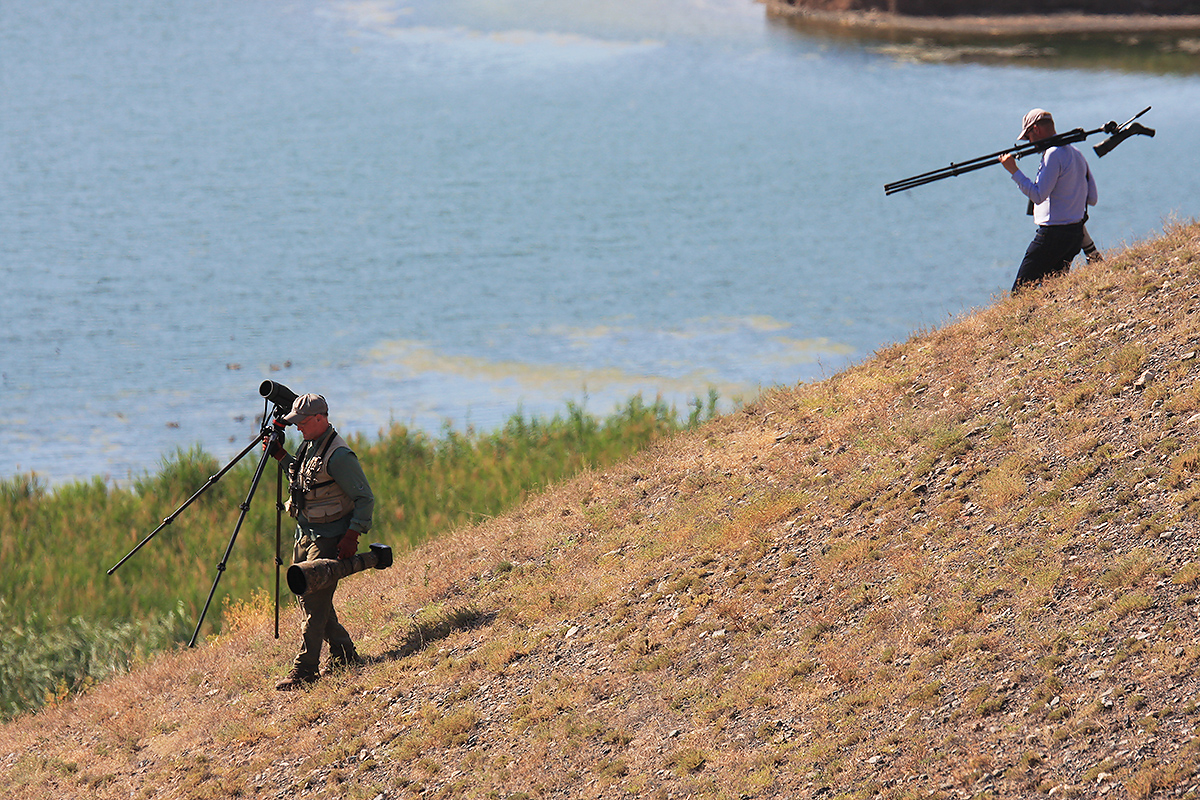
Yili Hotel (伊犁大酒店), +86 (0) 991-5198060
Address: 沙依巴克区长江路339号
Coordinates: 43.787162, 87.593397
Convenient location in downtown Urumqi, near several excellent Xinjiang-style restaurants and fruit stores selling dried Xinjiang fruit. Clean room, friendly staff. Restaurant and tea bar downstairs. We also stayed here our final night.
Selected eBird Lists
Baiyanggou, 20 July
Baiyanggou, 21 July
Baihu, 21 July
SAT 22 JULY
Beishawo, Daquangou Reservoir, Mushroom Lake
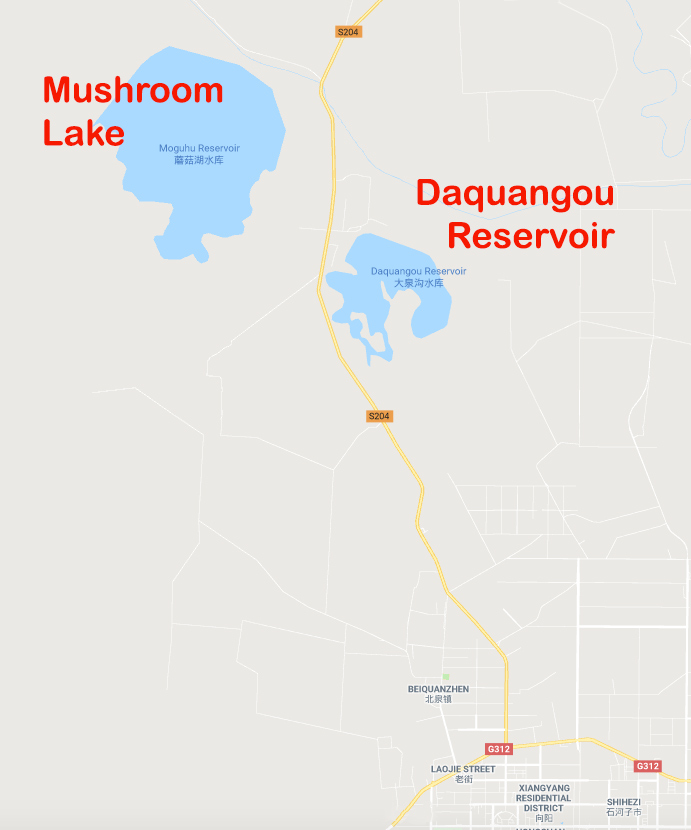
On Sat. 22 July, Jan-Erik and I left Urumqi and began our journey north. Our first stop was Beishawo (44.374603, 87.881042), an outstanding semi-desert site 85 km (53 mi.) north of Urumqi. Later, we birded Daquangou Reservoir (44.424510, 85.989695), a compact wetland 170 km (106 mi.) northwest of the provincial capital.
Beishawo delivered four species of sparrow: Saxaul Sparrow Passer ammodendri, House Sparrow P. domesticus, Spanish Sparrow P. hispaniolensis, and Eurasian Tree Sparrow P. montanus. We also had here our only trip record of Barred Warbler Curruca nisoria.
At Beishawo I jumped out of the car into the scrub—and came face to face with a European Nightjar Caprimulgus europaeus. The goatsucker was roosting on a tamarisk. Soaring overhead was Long-legged Buzzard Buteo rufinus rufinus. We missed Eurasian Stone-curlew Burhinus oedicnemus and Rufous-tailed Scrub Robin Cercotrichas galactotes.
After a long drive west through new towns and farming communities populated by Han settlers, we arrived at Beihu, also known as Daquangou Reservoir, north of Shihezi. Here I had my first-ever look at Great Reed Warbler Acrocephalus arundinaceus, yet another Central Palearctic breeder confined in China to Xinjiang.
At Daquangou Jan-Erik and I counted 2500 Pale Martin Riparia diluta, 400 Black-tailed Godwit Limosa limosa, 120 Pallas’s Gull Ichthyaetus ichthyaetus, and a lone Eastern Imperial Eagle Aquila heliaca roosting on a spit amid hundreds of wary gulls and shorebirds. We had 2 Ruff Calidris pugnax in breeding plumage, 20 Curlew Sandpiper C. ferruginea, and 130 Temminck’s Stint C. temminckii.
Our 35-minute visit to nearby Mushroom Lake yielded Western Yellow Wagtail Motacilla flava thunbergi.
On the long drive west to Daquangou, we passed through several checkpoints without incident. It is good to have a firm itinerary so that you can tell the police exactly where you intend to go. The procedure is uniform—a quick noting of passport numbers and sometimes questions about purpose of trip and destinations.
Photo
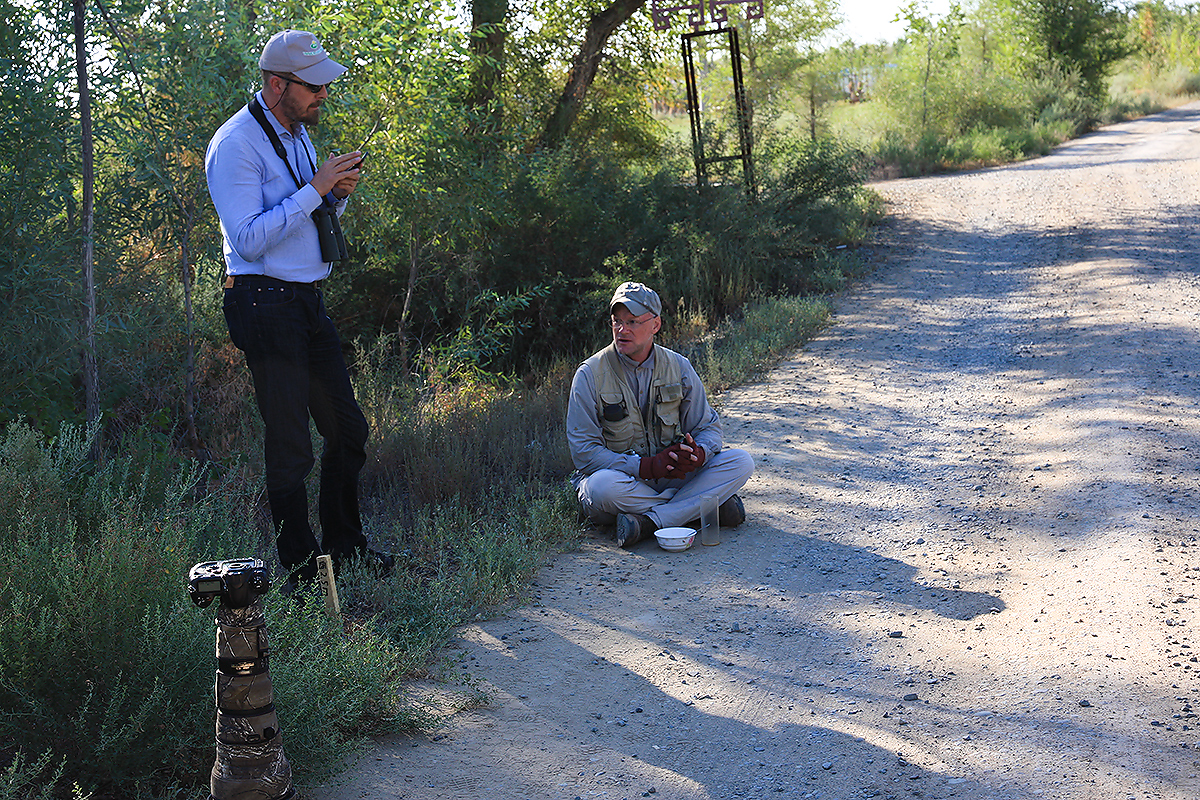
Beishawo, 22 July
Daquangou Reservoir, 22 July
Mushroom Lake, 22 July
SUN 23 JULY
MON 24 JULY
Hongyanglin, Beitun
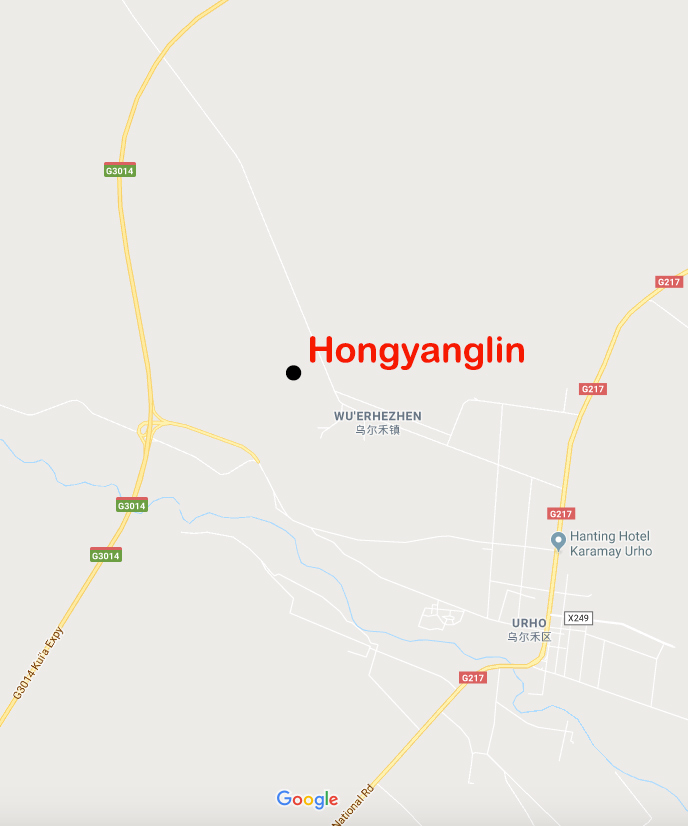
On Monday night, 24 July, our team was 700 km (435 mi.) north of Urumqi in Beitun, near Ulungur Lake. For the past two days we had been birding top-notch locations along the highways.
Our greatest highlights were at the amazing poplar forest at Hongyanglin (46.120667, 85.654611), where we had White-winged Woodpecker Dendrocopos leucopterus, Sykes’s Warbler Iduna rama, Shikra Accipiter badius cenchroides, Turkestan Tit Parus major turkestanicus, and singing Common Nightingale Luscinia megarhynchos. Earlier, at the excellent Kuitun Reservoir (44.770533, 84.608984), we had Whooper Swan Cygnus cygnus, European Bee-eater Merops apiaster, and singing Paddyfield Warbler Acrocephalus agricola.
A random stop in the semi-desert (46.326889, 85.918306) yielded Asian Desert Warbler Curruca nana and Henderson’s (Mongolian) Ground Jay Podoces hendersoni. A wood near a village (46.750637, 86.191788) got us Spotted Flycatcher Muscicapa striata plus Lesser Kestrel Falco naumanni mobbing the ubiquitous Black Kite Milvus migrans.
At Kuitun and at various places along the road we have had European Roller Coracias garrulus.
Photos
![Craig Brelsford (L), Jan-Erik Nilsen Kuitun Reservoir, Xinjiang, 23 July. (Sūn Yǒng Dōng [孙永东])](https://www.shanghaibirding.com/wp-content/uploads/2018/10/nilsen-brelsford-xinjiang-sun-yong-dong2017_3-1.jpg)
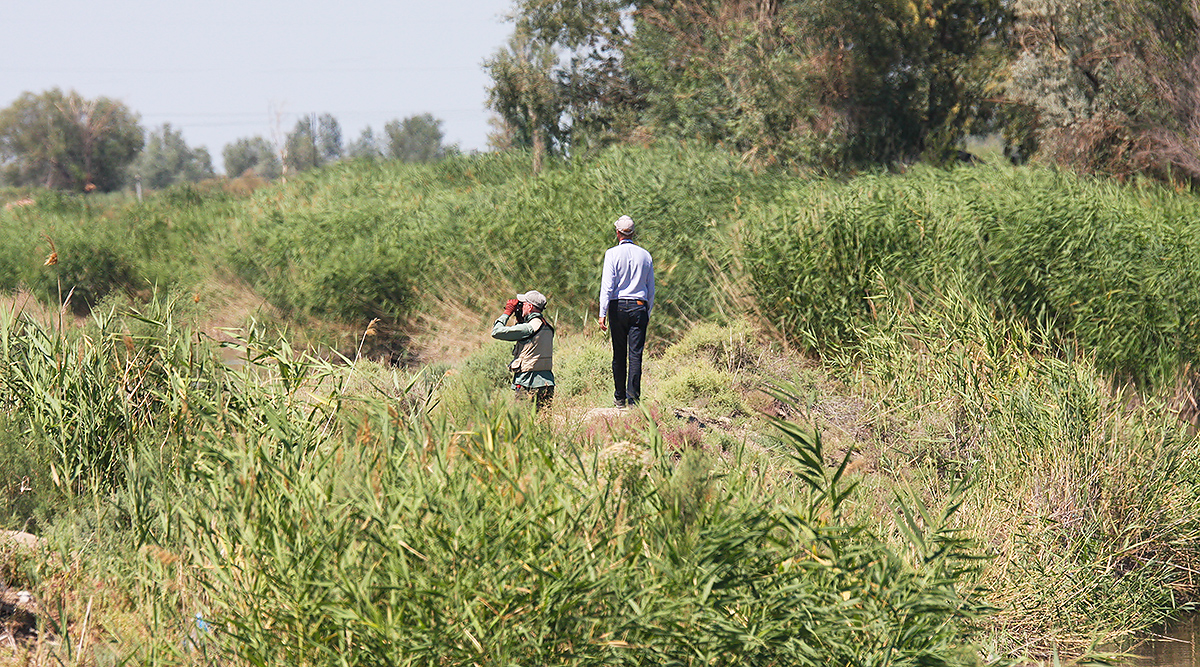
Kuitun Reservoir (North Side), 23 July
Kuitun Reservoir (East Side), 23 July
G217-S221 Junction, 23 July
Hongyanglin, 23 July
Hongyanglin, 24 July
Arid Country S of Heshituoluogaizhen, 24 July
Ahe’erbulage Cun, 24 July
Wutubulake, 24 July
TUE 25 JULY
WED 26 JULY
Ulungur Lake, riverine woodlands, Altai
On Tuesday 25 July and Wednesday 26 July, Jan-Erik and I birded Ulungur Lake and wetlands and riverine woodlands in the Jungar Basin. We were powering ever northward, and by the night of 26 July we were in the Altai Mountains, the northern tip of Xinjiang.
Among the highlights were a rare China record of Sedge Warbler Acrocephalus schoenobaenus. The wetland west of Kaba where the Sedge Warbler was found also gave us Paddyfield Warbler A. agricola and Pallas’s Grasshopper Warbler Helopsaltes certhiola, both singing, as well as juvenile Bluethroat Luscinia svecica and Black Stork Ciconia nigra. We looked for but could not find Corn Crake Crex crex.
Riparian woodlands line many of the streams feeding the mighty Irtysh River. These delightful, park-like poplar forests yielded many Palearctic passerines, among them Eurasian Golden Oriole Oriolus oriolus, White-crowned Penduline Tit Remiz coronatus, snowball-headed Long-tailed Tit Aegithalos caudatus caudatus, breeding Mistle Thrush Turdus viscivorus, Azure Tit Cyanistes cyanus, Tree Pipit Anthus trivialis, European Greenfinch Chloris chloris, and European Goldfinch Carduelis carduelis.
The birds most numerous in these riverine woodlands are Common Chaffinch Fringilla coelebs and the bright-yellow Great Tit Parus major kapustini. Among the common non-passerines are Lesser Spotted Woodpecker Dryobates minor and White-backed Woodpecker Dendrocopos leucotos.
The survey of lagoons at the northeastern corner of Ulungur Lake (47.339970, 87.553458) gave us a pair of Mute Swan Cygnus olor and Eurasian Oystercatcher Haematopus ostralegus. Anatids were well-represented; besides the Mute Swan, we also found Greylag Goose Anser anser, Common Shelduck Tadorna tadorna, and Common Goldeneye Bucephala clangula. Bearded Reedling Panurus biarmicus were present, and I once again stumbled on European Nightjar roosting in the scrub.
Drives in China’s largest province are long but we bird as we go. From the car we have seen European Roller and Saker Falcon Falco cherrug and heard singing Common Quail.
Photos
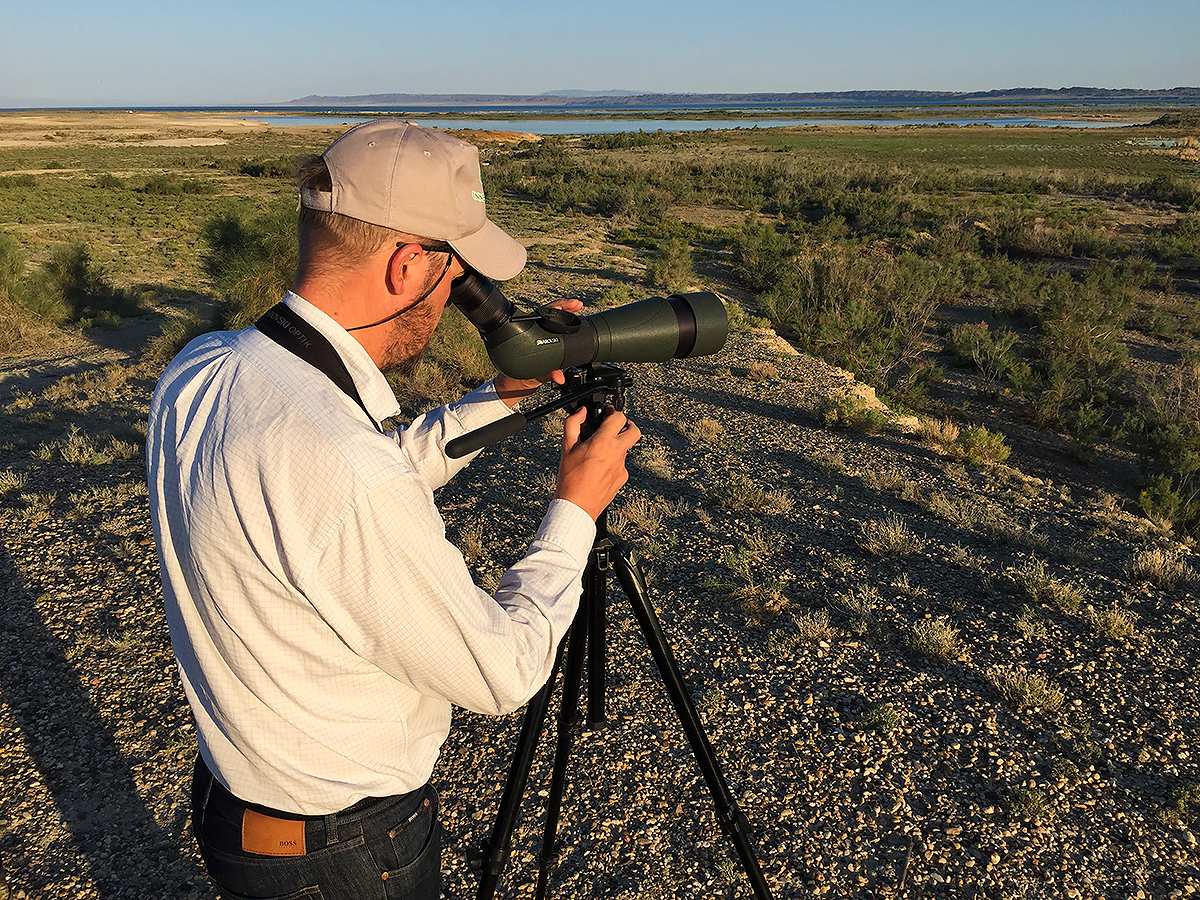
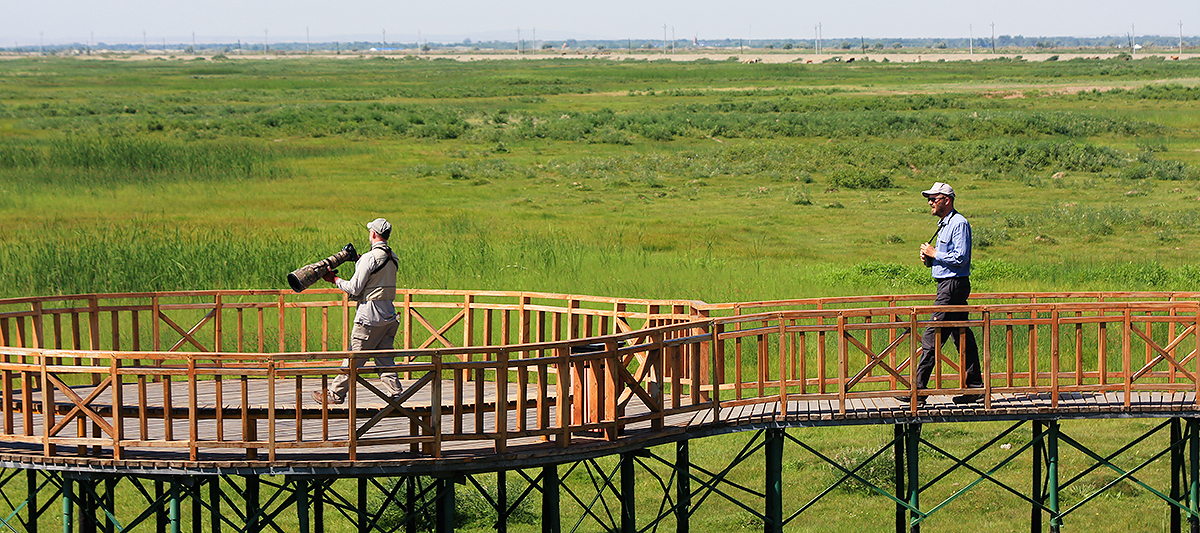

Selected eBird Lists
NE Ulungur Lake, 25 July
G216 42 KM S of Altai, 25 July
Alahake, 25 July
White Birch Forest Scenic Area, 26 July
Wetlands on S229 W of Kaba, 26 July
Biesikuduke Cun, 26 July
Burqin Magic Forest, 26 July
THU 27 JULY
FRI 28 JULY
SAT 29 JULY
Altai, Urumqi
Jan-Erik and I wrapped up the Xinjiang expedition with two days in the Altai Mountains at Kanasi Park followed by a long drive south across the Jungar Basin to Urumqi.
Kanasi yielded “European” species whose ranges in China extend only into Altai. Among them were breeding Siberian Chiffchaff Phylloscopus collybita tristis near our hotel and breeding Ortolan Bunting Emberiza hortulana found along our long mountain walk. Willow Tit Poecile montanus baicalensis also made here its only appearance on our trip list, and we had an unexpected encounter with Eurasian Siskin Spinus spinus.
The highlight of our walk was however supplied by a Central Asian species: Sulphur-bellied Warbler Phylloscopus griseolus, a wallcreeper-like bird and one of the most interesting leaf warblers in the world.
As Jan-Erik and I walked under a blazing sun, the heat intense, we admired, high on the cliff above, Common Rock Thrush Monticola saxatilis and Black Redstart Phoenicurus ochruros phoenicuroides.
Near the base, a nearly vertical rock face, I noticed movement. Sulphur-bellied Warbler were browsing the rocky surface the way their congeners browse the crowns of trees. In arid Central Asia, a leaf warbler has evolved that exploits a locally common but decidedly un-leafy habitat.
The drive of 760 km (472 mi.) back to Urumqi took two days. We broke up the trip with stops at promising habitat. Among the species we noted were Long-legged Buzzard, Henderson’s Ground Jay, and handsome Saxaul Sparrow.
We ended our birding Saturday at Qinggeda Lake near the provincial capital. The 160th and final species of our 10-day trip was Black Tern Chlidonias niger.
Photos
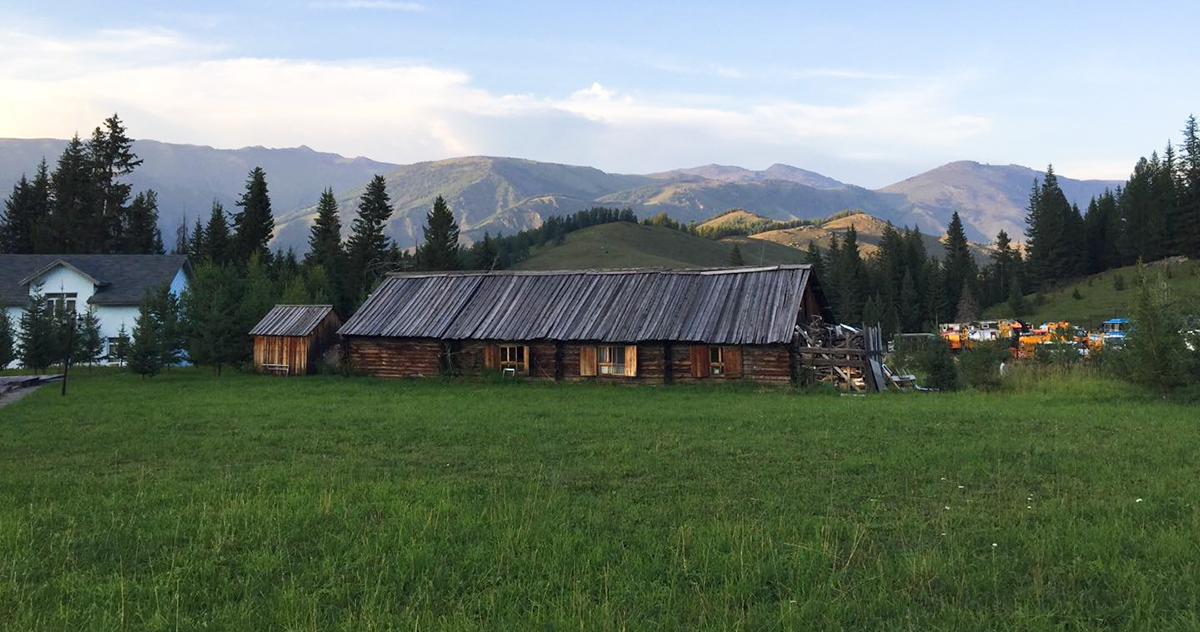
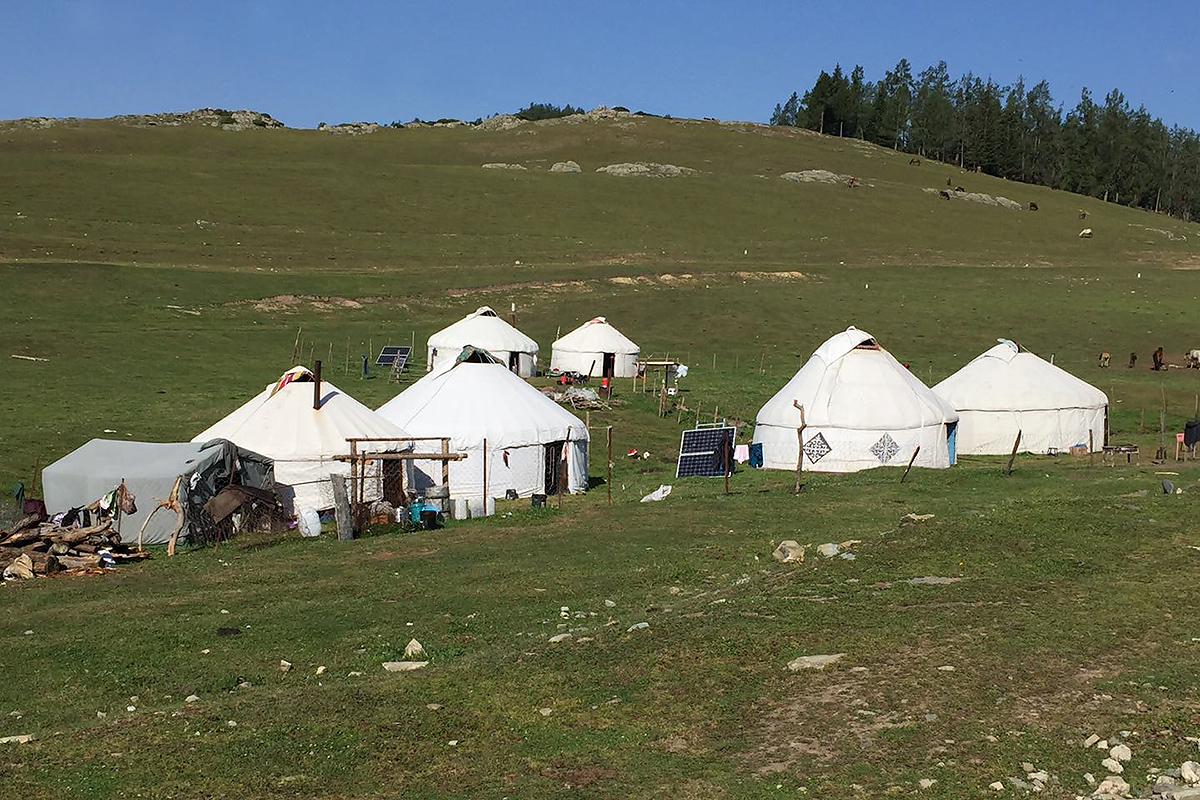

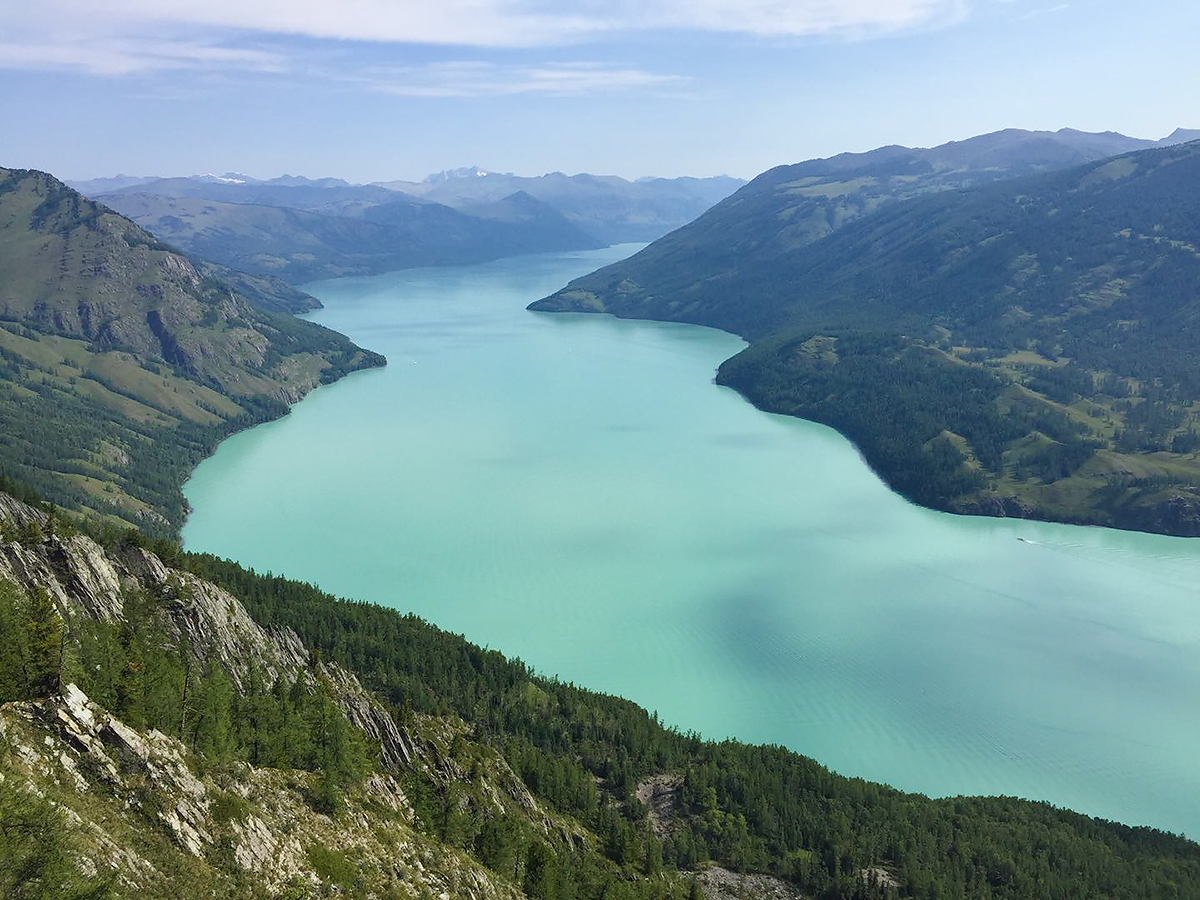
Selected eBird Lists
Guanyu Tai-Kanasi River, 27 July
Jiadengyu, 27 July
Jiadengyu, 28 July
Suwuke Basitao-Kanasi Airport, 28 July
Wutubulake Toll Station, 28 July
Arid Country S of Wuerhe, 29 July
Shengli Road-G217, 29 July
Qinggeda Lake, 29 July
This post is the second in a five-post series about birding in Northern Xinjiang.
 Northern Xinjiang, July 2017: Introduction: Craig Brelsford gives you an introduction to Northern Xinjiang and an overview of the expedition of July 2017. Bounded by the Tianshan to the south and the Altai to the north, and with the Jungar Basin at its heart, Northern Xinjiang is one of the premier birding areas in China.
Northern Xinjiang, July 2017: Introduction: Craig Brelsford gives you an introduction to Northern Xinjiang and an overview of the expedition of July 2017. Bounded by the Tianshan to the south and the Altai to the north, and with the Jungar Basin at its heart, Northern Xinjiang is one of the premier birding areas in China.
Notes on Birding in Northern Xinjiang (you are here)
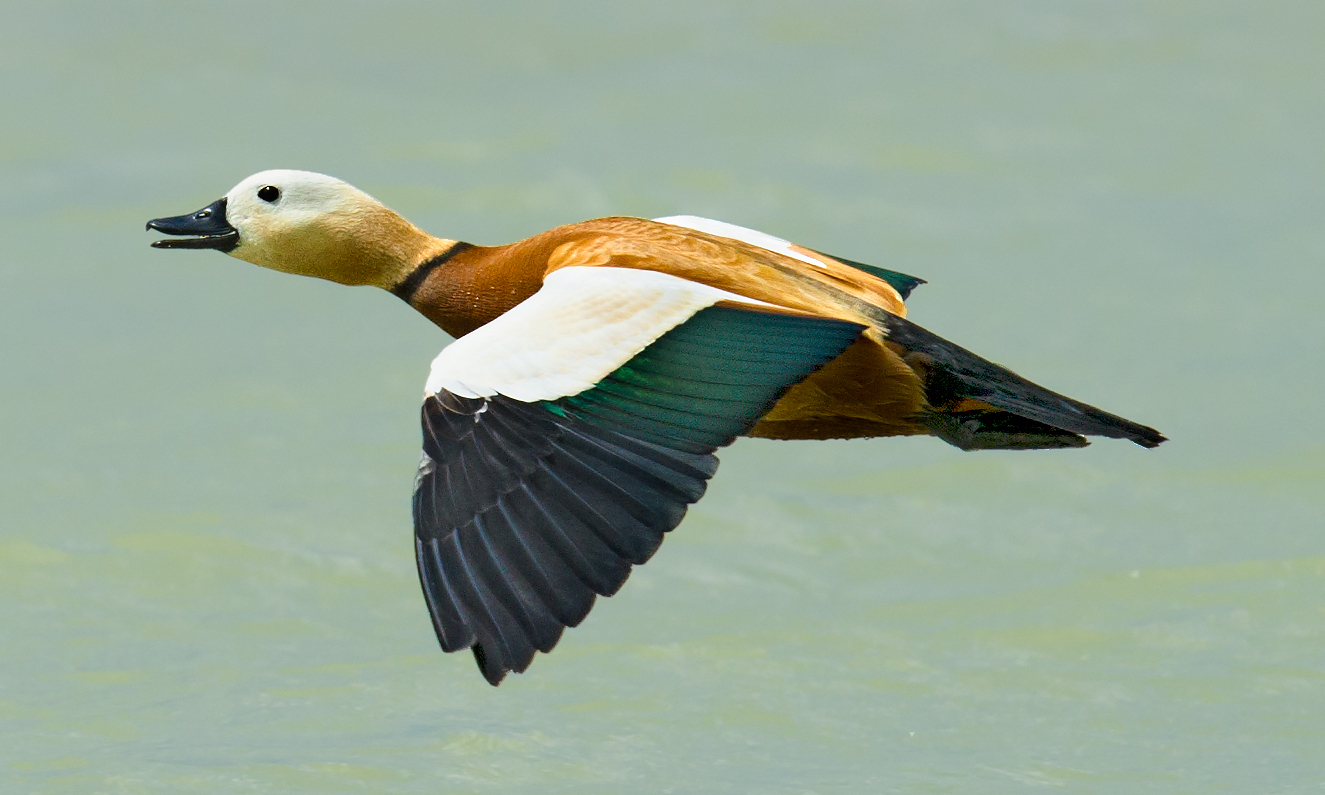 Photo Gallery of the Birds of Northern Xinjiang (Non-Passerines): This is the first of two photo galleries of the birds of Northern Xinjiang. This post covers non-passerines. Each photo in the gallery was taken by Craig Brelsford in Xinjiang.
Photo Gallery of the Birds of Northern Xinjiang (Non-Passerines): This is the first of two photo galleries of the birds of Northern Xinjiang. This post covers non-passerines. Each photo in the gallery was taken by Craig Brelsford in Xinjiang.
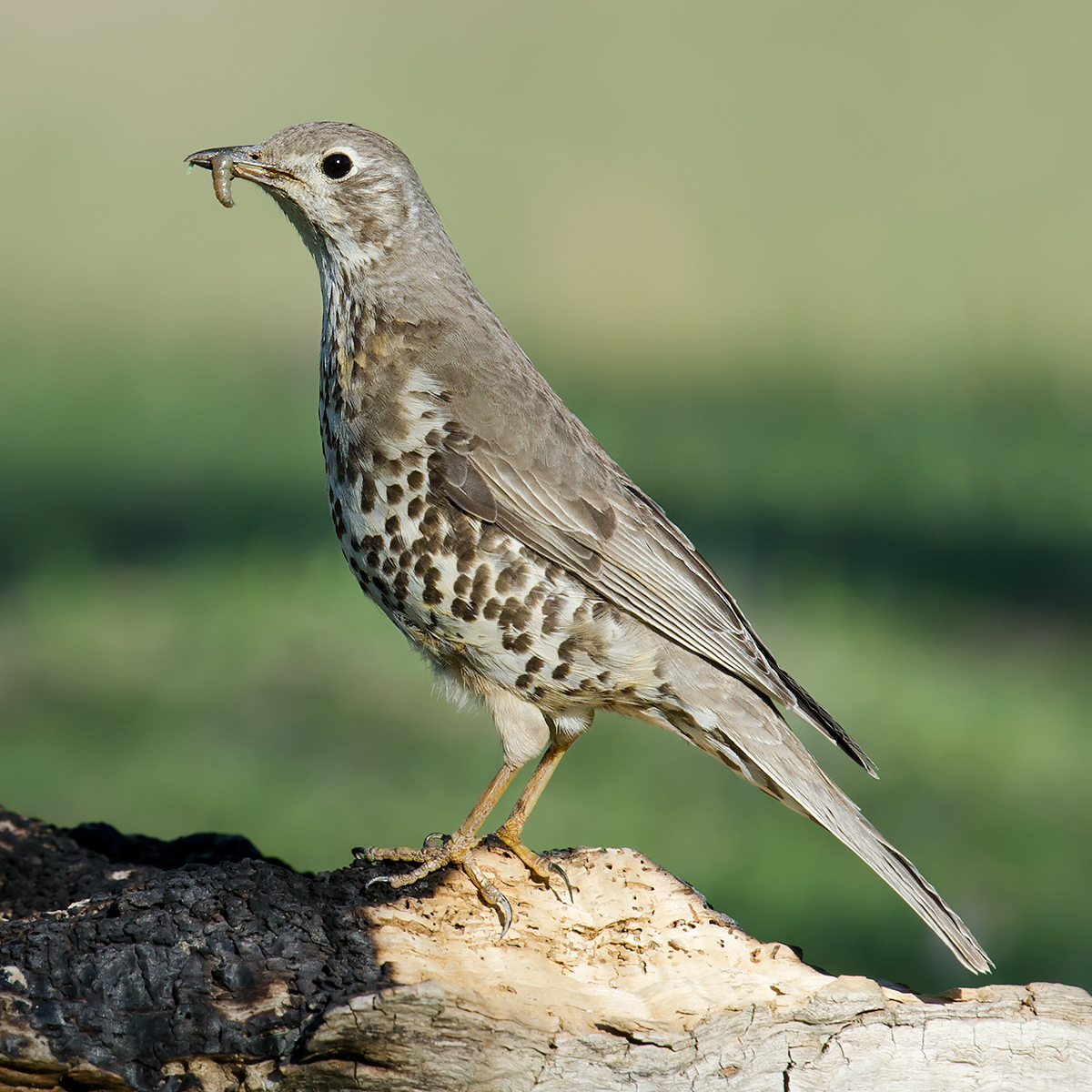
Photo Gallery of the Birds of Northern Xinjiang (Passerines): This portion of the photo gallery covers the passerines of Northern Xinjiang. Many birds well-known to Europeans, such as Mistle Thrush, were photographed by Brelsford using his state-of-the-art Nikon setup.
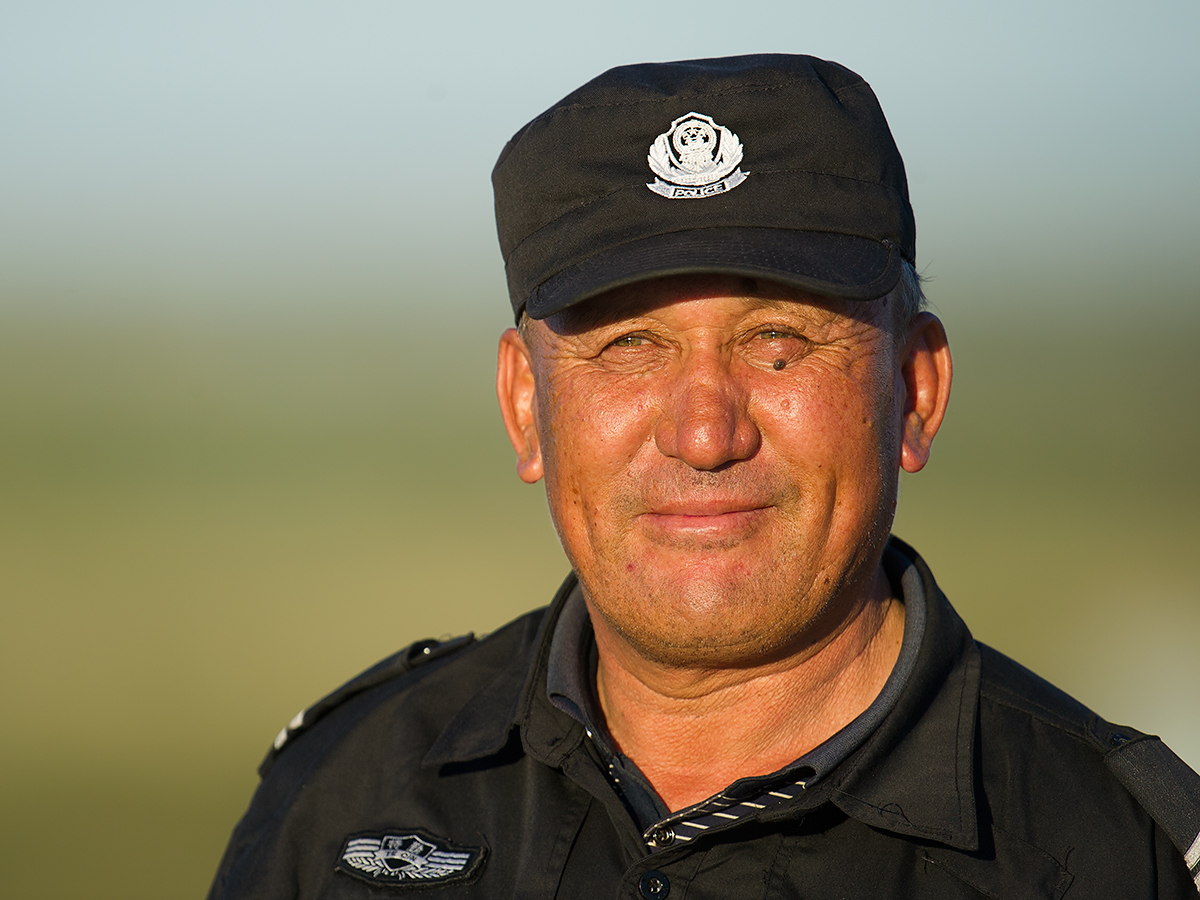
The Landscapes and People of Northern Xinjiang: Photos and detailed captions by Craig Brelsford offer a window into the habitats and people of Northern Xinjiang.
Other shanghaibirding.com posts on Xinjiang:
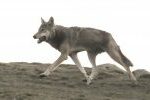
John MacKinnon in the Altai Mountains of Xinjiang: The visit of the pioneering naturalist included an encounter with wolves and records of Willow Ptarmigan and Rock Ptarmigan. “We emerged on top of the world,” MacKinnon writes, “with views way into the distance across the Mongolian border.”
